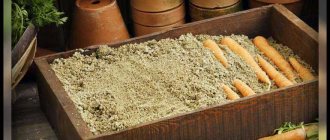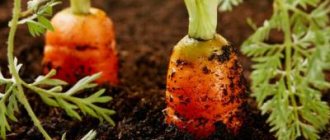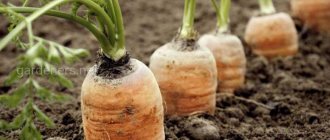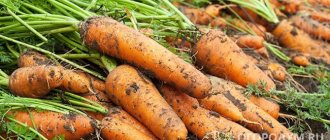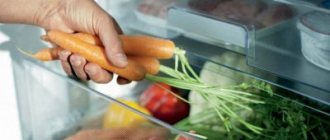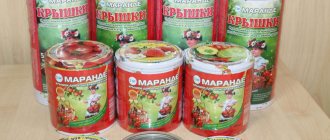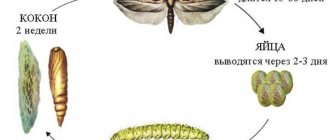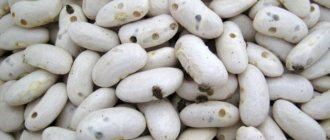Important rules for storing carrots and beets in the cellar for the winter
The harvested carrots and beets can be preserved not only until the winter cold, but also until next autumn.
A cellar is ideal for overwintering vegetables. There are several ways to store root vegetables. Subject to certain rules, agricultural products can be stored both together and separately.
Let's take a closer look at how to properly store carrots and beets for the winter in a cellar, underground or basement.
Can it be stored together?
Orange and burgundy root crops have similar requirements for winter storage. They have the same required level of temperature and humidity. Harvesting of these crops also occurs at the same time.
Both varieties of vegetables winter well in:
This allows you to leave carrots and beets in the same cellar until spring, even in the same container.
Despite such similar characteristics, root vegetables have some differences. Beets are considered a more shelf-stable crop, carrots – more capricious.
That is why ideally these vegetables are kept separately . If this is not possible, then placing them in one box, it is necessary to separate the cultures with a layer of filler.
It is not recommended to place carrots and beets close to each other. At the same time, being together in the same cellar does not affect the quality of both vegetables.
Preparation for storage in the underground or basement
After digging out of the ground, root crops must be fully prepared for underground storage. Ignoring this stage is fraught with rapid spoilage of plant products.
The preparatory process consists of successive steps:
- The dug up vegetables are dried in the fresh air in the shade.
- Remove dirt from the surface with a dry mitten or rag.
- Root vegetables are calibrated, removing damaged and diseased ones.
- Cut the tops of carrots and beets to a height of 5-10 mm.
- The cut is powdered with chalk powder or ash.
Read about how to prepare carrots for long-term storage here.
How to understand that a root crop is sick?
Disease is the process of damage to a vegetable crop by infectious agents such as bacteria, fungus or a virus, which manifests itself in the form of spots, mold and rot, both on the foliage and on the roots.
At first glance, it is difficult to understand why a crop is spoiling, be it a parasite or some kind of disease.
When initial signs of damage appear, it is necessary to identify the cause of their occurrence.
If a crop is spoiled by a pest, you need to inspect the leaves and tops to find the dangerous insect that is harming the vegetable. If a root crop is affected by a disease, you should determine its type and decide how to treat the vegetable. What diseases and pests can affect the plant are described in detail in a separate article, but here you can read about the main pests of carrots.
How correctly, under what conditions?
Regardless of the method of planting the crop, it is necessary to adhere to some general rules. The air temperature should remain stable throughout the months.
Its range can vary within a narrow limit: from 0 to +4 degrees. Lower temperatures cause vegetables to freeze, while higher temperatures cause them to sprout.
In both cases, the product spoils. In addition, the cellar is made ventilated and darkened. The air humidity in the room where the root vegetables are stored should be 85-95%.
In the sawdust
Sawdust and wood shavings are suitable for storing carrots
This material perfectly regulates humidity and serves as a thermal insulation layer.
A layer of sawdust 2-3 cm thick is poured into the prepared containers. The vegetables are placed vertically on a loose “cushion” with the wide end down, close to each other. Sprinkle wood filler on top so that it covers the tops of the carrots.
In sand
Sand filler is disinfected by heating over an open fire or in the oven . Another method of disinfection is soaking the sand with a strong solution of potassium permanganate. But after this procedure, the substrate should dry well.
To prevent the products from rotting, chalk is added to the sand. A layer of sand is poured into the boxes and one type of root crop is placed. Cover the vegetables with filler so that they are not visible.
Place a second row of carrots or beets. Covered with sand again. For beets, the sand is slightly moistened.
Containers are placed on racks or the floor . In the latter case, the boxes should stand on a grid or stand. In sand in cellar conditions, vegetables retain their quality for up to 6-8 months.
In onion skins
Dry onion wrapping absorbs excess moisture and protects agricultural products from fungal contamination. The husks are poured into a box or bag.
Root vegetables are placed in such a way that each specimen is surrounded by filler. The containers are covered with a lid, and the bags are tied with a rope and sent to the cellar.
In the ground
High-moor peat is used as an earthen filler . It should be a loose, slightly decomposed substrate. It is dried and the humidity level is adjusted to 40-50%.
Several more ways to store carrots in the ground are discussed in this article.
In a plastic bag
Large bags made of polypropylene or polyethylene are suitable for storage. Vegetables are placed in bags, then sealed or tied tightly.
Polypropylene bags are semi-permeable, so they allow air to pass through . Plastic bags do not have this feature, so they are pierced with a thick needle in several places.
The bags are placed on prepared racks or hung on a hook in the cellar. You can find out how to store carrots in bags here.
In clay
Before planting root crops, it is necessary to prepare a clay substrate . To do this, it is moistened with water for several days. Clay saturated with moisture acquires a creamy consistency.
The wooden box is lined with film or polyethylene. If an enamel or plastic container is used for storage, a waterproof layer is not needed.
Next, the root vegetables are placed in a container in one layer and filled with mash .
After the clay “sets” slightly, lay out a layer of carrots or beets again and pour over the clay filler.
Possible problems and solutions
During storage, problems may arise that affect the quality and shelf life of products. The most important ones are related to changes in temperature, humidity, and the appearance of fungus.
Every problem has its own solutions.
Change in temperature . If the cellar is poorly insulated during the winter months, the temperature may drop or rise.
If the thermometer shows a critical level below zero degrees, a bucket of smoldering coals can help out. When the temperature rises, the cellar should be ventilated.
- Change in humidity . This indicator can be adjusted using salt and charcoal. Moisture-absorbing filler is poured into boxes and placed in the corners of the room.
- The appearance of mold . Lime is used to disinfect the cellar. It kills pathogenic fungi and dries the air at the same time.
To reduce fungal infection of root crops, it is useful to use plants that secrete phytoncides. To do this, carrots and beets are arranged with sprigs of fern, rowan, and tansy.
White rot (sclerotinia)
One of the most common diseases affecting carrots during storage. It is caused by a fungus that is not active in the summer, but “wakes up” by the time the root crops ripen, and at a temperature of 15-20°C it begins to grow. White rot can be detected during the harvest period. Sources of infection can be soil, storage facilities and premises in which vegetables and infected plant residues are stored. The peak of disease activity occurs 4-9 weeks after carrots are placed in storage.
First of all, the fungus affects unripe, overripe, withered or supercooled root crops during harvesting. The infection attacks all vegetables located in the “affected zone”; fruits are not suitable for food. Sick carrots cannot simply be thrown away, especially in the compost heap. Fungal spores can remain on walls, other plants and tools and will attack the crop again next season.
Symptoms : the tissue of the root crop in the affected areas becomes soft, loose and moist (slimed), while the color of the carrots does not change. Subsequently, the “wounds” are covered with a layer of filamentous mycelium of pathogenic fungi, similar to white cotton wool. Over time, it thickens, droplets of liquid appear on it, and then hard and large black growths form.
Measures to combat white rot:
1. Observe crop rotation - plant carrots in the same place only after 3-5 years, and its predecessors should not be cucumbers, tomatoes, parsley, lettuce and cabbage. 2. Harvest the harvest from the garden in a timely manner, sort it carefully and store it at the optimal temperature (0-2°C, with a humidity of 85-90%). 3. Treat the storage room with a solution of bleach: dilute 400 g of lime in 10 liters of water and spray the walls and floor of the room, using 2-3 kg of the substance for every 10 cubic meters. After disinfection, ventilate the room. 4. Whitewash wooden shelving (if any) with lime milk. To do this, dilute 1 kg of lime in 10 liters of water and apply the solution to the racks in an even layer. 5. In the spring, before sowing, add 4-5 kg of humus, 20 g of superphosphate and 10-15 g of potassium chloride to the soil. Do not forget to apply phosphorus and potassium fertilizers in the future. 6. Choose carrot varieties that are resistant to white rot. Burn affected fruits.
The following carrot varieties are considered relatively resistant to white rot: Aristo, Artek, Callisto, Magno, Forto.
Tips and prohibitions
To prevent the harvest from spoiling, it is necessary to take into account some nuances . They relate to harvesting, creating conditions in the cellar, and proper preparation of storage and vegetables.
Experts recommend storing mid- and late-ripening varieties for long-term storage:
| Variety/Vegetable | Carrot | Beet |
| Late ripening | Queen of Autumn, Red Giant, Vita Longa, Emperor | Renova, Gribovskaya, Incomparable, Egyptian flat |
| Mid-season | Nantskaya-4, Samson, Nectar F1, Moscow winter | Bohemia, Top Hat, Opolskaya, Patrick |
Another factor that affects the safety of vegetables is the harvest time. It is most optimal to dig up root crops in late September - early October.
A guideline for a successful harvest period can be 2-3 yellowed lower leaves in the tops. Be sure to choose a dry day for cleaning.
There are several taboos that are worth remembering when planting and storing carrots and beets underground. In particular, it is strictly not recommended:
Harvest in rainy weather.- Wash vegetables before placing in containers.
- Place undried root vegetables.
- Leave rotten specimens in the cellar.
- Keep the storage temperature above +5 degrees.
- Keep root vegetables and apples in the same room.
Carrot diseases. How to store crops in the cellar
Sometimes you pull a carrot out of the garden and see spots and growths unusual for a root vegetable, and sometimes you find rotten areas. Late blight quickly becomes noticeable on tomatoes, but carrot diseases are quite difficult to discern.
The loss of the harvest can be significant, but still much more unpleasant is the death of all the root crops stored for storage.
How does a root crop in the garden differ from a root crop in the cellar?
In open ground, our vegetable plants have to withstand natural aggressors: hail, showers, and dry winds. They hurt, they suppress the plant's immunity, which leads to a higher susceptibility to disease. Fog and dew are the worst. They create particularly favorable conditions for pathogens.
A carrot in the cellar is still the same living organism, but its physiological stability is reduced when compared with plants in the garden. Gardeners harvest and store ripe vegetables; they contain a lot of nutrients. This is good for the gardener himself and for microorganisms. We know that absolutely healthy tubers or root vegetables must be stored in the cellar. But sometimes signs of disease are not always visible. Both damaged and slightly unripe specimens end up in containers.
And storage conditions do not always correspond to a specific vegetable, because a gardener usually has one cellar for potatoes, beets and carrots, and another for barrels of pickles. This is the best case scenario. For these reasons, you can lose almost half of the carrots harvested for the winter, or rather, until the new season. This number is very approximate, because it is not clear - from what point do we have to count? From what was pledged for storage or from what was left for some date.
Diseases of carrots that affect root crops during storage
That is, in the cellar or basement.
White rot or sclerotinia Carrots are especially affected by this fungal disease during storage. The root tissues become soft, but retain their carrot color. Cotton pads grow on the surface (this is how the mycelium shows itself) which quickly spread to neighboring carrots. Vata changes over time: at first it becomes dense, then changes color to black, and drops of water appear on the surface. Usually appears in patches rather than as a continuous cover. Unfortunately, problem areas on root crops are not immediately visible, so gardeners, if they grow the seeds themselves, plant specially selected large carrots in the ground in the spring. That's where they quickly rot, as soon as the leaves grow.
Prevention of the problem : lime acidic soils, store at a temperature of 0°C, put only intact root crops in the cellar. Treat storage areas and do not reduce the temperature until the carrots may freeze.
Important ! When feeding infected carrots to cows (even with cut out areas of rot), the passage of feed through the intestines of the animals does not kill the pathogen; it ends up in the manure. In the spring, sclerotia (something similar to fungal spores) germinate and attack the plants. There is no need to use manure or humus for autumn fertilization for digging!
Wet bacterial rot Destroys not only carrots, but also its relatives: celery, parsnips, parsley. Sometimes it is found in the garden beds. But more often - during storage. In the garden, watery spots appear at the tip of the carrot root, and the tops wither. In the cellar, root vegetables decompose into an unpleasant-smelling wet substance.
Problem prevention : Cleaning and treating cellars and basements, storing healthy vegetables, storing them in a temperature range from 0°C. +2°C.
Black rot or Alternaria When growing root crops, you can sometimes find yellowing and dying leaves in the beds. There are few of them, sometimes one or two. During storage, slightly depressed spots are visible on root crops: they are dry, dark, and mycelium is noticeable on the surface in the form of a grayish-greenish coating. If you cut a carrot, you will see a black lesion. Root crops become infected in the garden, and the disease develops when stored in the cellar. If, when growing carrots for your own seeds, you notice that the mother plants do not throw out greens, it means that the tissue at the growth point is damaged. Such specimens need to be urgently removed from the beds and the soil disinfected. However, before planting it is necessary to treat the seeds, because the pathogen is waiting in the wings on them too.
Problem prevention : crop rotation or soil disinfection, storage at temperatures from 0°C. +1°C with a humidity of no more than 90%, treatment of cellars and basements.
Dry brown rot or fomoz It is found in the summer on the leaves in the form of spots in a brownish-gray color scheme. At the end of summer, brownish-gray or elongated or oval spots with dots in the center are noticeable on the underground organs. When stored, carrots become hollow, the tissue becomes loose, and the color becomes brownish-brown. In humid, cool summers on sandy soils, carrots are more affected. Preventive measures and storage conditions are the same as for alterniosis.
Important ! Pycnidia of the fungus remain in manure and humus! If you need to feed it to animals, then be sure to cook it!
Diseases of carrots that affect the plant during the growing season
That is, in the garden. There are two diseases that cause changes in leaves. These are brown leaf spot and bacteriosis.
Brown leaf spot Leaves and petioles are covered with brown spots, with a yellow halo visible around the spots. Localization: first on the edges of leaf blades, and then damage to the entire surface of the leaf and petiole. The leaves change color to brown, then curl and dry out. If all or many plants are affected, then the bed looks like a burnt field. Carrots can throw out new green leaves when the old ones dry out.
Prevention of the problem : crop rotation or soil disinfection, disinfection of seeds before sowing, treatment of plants during the growth period.
Bacteriosis Yellow spots are visible on the tips of the leaves, then the spots darken and become brown. The tissue around them turns yellow. Dark brown watery spots appear on the stems, often in the form of stripes. The places where the leaves are attached darken and become wet, and brown spots similar to cankers are visible on the roots.
Preventive measures : see Alternaria.
Felt disease or rhizoctonia disease The disease affects grown root crops in the second half of summer, if the weather is warm and rainy, and carrot plantings are in low-lying areas. Lead-gray spots with a reddish-purple tint are visible under the skin of root vegetables. This is the color of a mushroom. Then black dots will appear. When stored in basements, such carrots rot. Preventive measures : crop rotation or soil disinfection, liming of the soil.
This is what carrots affected by the disease look like (from left to right, top to bottom):
You can cope with carrot diseases. And it is not at all necessary to use fungicides.
How to disinfect the soil so that carrots don’t get sick
It is recommended to pour boiling water over it, roast it in frying pans or in the oven. This is not even a method for seedlings. And even more so for a garden bed, and more than one. There is a drug Flora-S. And the drug Fitop-Flora-S. It is enough to treat the soil first with the first preparation, and after 2 weeks with the second. At the same time, carrots can already grow in the garden.
These preparations are approved for processing storage facilities, even if root crops are already stored in them. Because they contain no toxic or poisonous substances, only humic acids and Bacillus subtilis.
Diseases that may occur during storage
The harvested crop can be destroyed by a number of ailments, so it is important to regularly inspect the fruits and promptly select root crops affected by bacteria.
White rot (sclerotinia)
A fungal disease that occurs during storage of vegetables. The main symptoms include softening of the tissues, followed by their covering with a white coating resembling cotton wool.
The latter thickens over time, drops of liquid form on it, as well as black dots - sclerotia. In order to prevent infection of carrots, it is necessary to observe crop rotation, regularly apply fertilizers, and also store the crop at a temperature of 0 ... + 2 ° C and a humidity of 85–90%.
Important! Sluggish and supercooled root crops are more susceptible to botrythiosis, so it is necessary to harvest on time.
Gray mold (botrythiosis)
The pathogen develops during fruit growth and storage. It appears through small tubercles and brown spots on the surface of carrots. The area of the affected tissue gradually grows and becomes covered with gray-green fluffy mold. To prevent re-infection, it is necessary to disinfect the soil. To do this, use a solution of copper sulfate at the rate of 30 g per 10 liters of water. After harvesting, the area is irrigated with the product (1 liter of active substance is needed per 10 m²).
Black rot (Alternaria blight)
The bacteria affect young plants from planting to the 3-4 leaf phase, as well as after harvest, directly in the basement. The foliage of a diseased plant turns yellow, blackens and curls, and the root crop becomes covered with black dry rot. To combat the pathogen, use a 0.5% Tigama solution. It is used to treat seeds before planting and the harvested crop.
Scab (rhizoctoniosis, felt disease)
A fungal disease that occurs both during the growing season and during storage. Infection occurs through soil, contact and containers. The foliage of a diseased plant withers. On the fruits, in turn, dark gray spots appear, which are covered with a purple-brown fluffy coating.
To prevent infection, crops follow crop rotation: preference is given to soils after mustard, lupine, rye, rapeseed and oats. In areas of infection, the soil is limed: 350 g of dolomite flour or crushed limestone is used per 1 m².
Fomoz (dry or brown rot)
Affects carrots at all stages of growth. Characterized by the presence of gray shallow pits and furrows. In these places, complete tissue destruction occurs, right down to the core. First of all, the disease manifests itself at the tip and gradually affects the entire fetus.
Before storing the harvest, it is necessary to disinfect the cellar. To do this, use a 40% solution of formaldehyde or copper sulfate in a ratio of 1:45.
Fusarium rot
The diseased root crop becomes covered with dry ulcers. The top layer cracks and pink tissue is visible. After some time, the fruit dries completely. As a control measure, use a 5% solution of “Fundazol”, in which the planting material is soaked.
Methods for storing carrots in the cellar in winter
Currently, gardening and growing vegetables has moved from being a household necessity to more of an activity for the soul and for pleasure. How nice it is to harvest at the end of the summer season and enjoy its fruits all winter! However, it is important not only to collect your own grown vegetables and root vegetables, but also to properly preserve them during the long frosty winter, when the lack of vitamins and summer sun is especially acute. One of the most capricious root vegetables in terms of storage is carrots. How to store carrots in the cellar so that they do not spoil or rot is a question that amateur gardeners regularly face. Today I will list some of the most popular and effective methods.
To preserve carrots throughout the winter, you must, first of all, correctly collect them from the garden, in other words, the success of storage is laid down at the harvesting stage. In addition, the degree of preservation of carrots in a cellar or basement directly depends on its variety.
There are many other subtleties on which the safety of your harvest during the winter depends, let's look at them in more detail.
Black rot (Alternaria blight)
One of the most common and unpleasant diseases that turns carrots into a “charred” root vegetable. The causative agent is a fungus. It penetrates into the fruit after an attack by a carrot fly or mechanical damage. Even a small scratch or injury is enough for them to become a gateway to infection. The fungus can live anywhere - in infected seeds, in the soil and sometimes even on garden tools.
Symptoms : dry and dark, slightly depressed spots appear on the affected fruits. Dead tissue turns black over time, becoming charcoal dark. The stain penetrates 1-1.5 cm deep into the pulp and has clear boundaries. A dark olive-colored coating of fungal mycelium remains on the spots. The fungus loves tropical conditions - air temperatures up to 28°C and humidity 95-100% and therefore, when brought into a cold room, does not show activity.
Measures to combat black rot:
1. Store carrots in a dry and cool place, maintain temperature conditions (0-1°C) and maintain humidity at 80-85%. 2. Maintain crop rotation and plant carrots in the same bed only for 4-5 years, fight weeds that are carriers of infection. 3. Before sowing, improve the health of the seeds. You can do this this way: keep them in warm water at a temperature of 50-55°C for 15 minutes, and then dip them in cold water. In the future, the seeds can be treated with TMTD 80% (8 g per 1 kg of fruit). 4. Before planting in the spring, treat the queen cells with a 3% TMTD suspension in accordance with the instructions. 5. Disinfect the storage with lime and destroy post-harvest residues.
The following carrot varieties are considered relatively resistant to black rot: Dordogne, Champion F1.
Proper cleaning and drying of carrots
Traditionally, late-ripening varieties are grown for long-term storage, with a growing season (development time) of more than 120 days; you can also use mid-ripening varieties - the most popular in private farms, but we’ll talk about choosing a variety in the final part of the material.
Harvesting carrots is best in dry, warm weather, since root crops removed from dry or slightly moist soil will only need to be dried a little. Carrots need to be dried before they are stored in the cellar for storage. Harvesting in the middle zone can begin in mid-September. The season ends, as a rule, in mid-late October, which largely depends on the number of sunny days, because carrots can be characterized as a long-day plant, whose photoperiodism requires more than 12 hours of light for successful ripening. The first light frosts of carrots are not terrible, so you don’t have to worry about it.
It is better to dig up carrots with a pitchfork, holding each root vegetable by the tops, but you can also use a garden trowel. It is better not to use a large shovel, or just dig up the ground a little and carefully pull out the root crops. If the soil is loose and dry, this will be quite easy to do.
When harvesting, try not to damage or scratch the carrots, since if the skin is damaged, the vegetable will not be stored well and will quickly rot.
You need to dig up the carrots carefully so as not to damage the peel.
In good weather, it is enough to spread the harvested crops outside and dry for several hours. If you are unlucky with the weather - it’s damp and raining outside - you need to collect the carrots and evenly spread them out to dry in the house or garage. We recommend spreading the carrots in one layer on a dry mat. It is advisable that individual vegetables do not touch each other. Raw root vegetables need to be dried for several days - this is the so-called quarantine period.
After the carrots have dried, you need to perform the following manipulations with them:
- We clear away excess soil. After the moisture has dried, you need to carefully clean the root vegetables from dirt. If the soil in your area is clayey and the lumps of earth have dried up, let them remain.
- We select root crops damaged during harvesting. Only healthy, whole and strong vegetables should be stored in the cellar. If the carrot peel is damaged, pathogenic microbes will immediately penetrate there and the process of rotting will begin. It is well known that one spoiled root vegetable can infect everyone around it. Therefore, special attention should be paid to the carrot sorting stage. Take the rejected vegetables home and put them in the refrigerator for prompt use, and if you come across cracked root vegetables, but these cracks are dry and do not cause suspicion, they can be stored, however, they still need to be used first.
- We sort the carrots by size - separate the small ones from the large ones. First, small vegetables will be eaten, then medium-sized ones, then the largest ones.
- We remove the tops. Using a sharp knife, you need to cut off the tops at a distance of 1–2 mm from the root itself.
Sometimes carrot tops are cut off before harvesting (1-2 weeks), but whether this method is justified is a big question, and it is much more convenient to pull root crops out of the ground, holding onto the tops.
Now our carrots are ready to be stored, and we move on to the next stage. The ideal place for winter storage of root vegetables is a basement or cellar.
Causes of carrot rot
Often, after harvesting, vegetable growers notice that the carrots lying in the cellar begin to rot. This happens for the following reasons:
- the summer was rainy, the crop was often watered, which is why water stagnated in the beds, the soil was waterlogged;
- the weather in summer was cold, the earth was not warmed up well;
- the soil is poor in potassium;
- It rained during harvest, so the carrots ended up in storage raw;
- root crops were collected after frost;
- the vegetables were not sorted before being placed in storage, so damaged or diseased specimens ended up in the cellar;
- the harvest was kept at high humidity and air temperature.
Even one of these reasons leads to the appearance of mold, and when several factors are combined, the risk of vegetable spoilage increases. Most often they are affected by brown and dry fusarium rot.
Preparing the cellar
Carrots are one of the most difficult and capricious root vegetables to preserve. In order not to rot, dry out or germinate, it needs special conditions, namely a temperature of -2 - +2 degrees and an air humidity of 90 - 95%. Ventilation in the cellar should be of medium intensity; if there is too much air, germination will inevitably begin.
Do not store carrots and other root vegetables in the same room as apples. This is explained by the fact that apples (especially ripe ones) actively emit ethylene, which leads to rapid spoilage of vegetables.
In order to ensure the required microclimate in the cellar or basement, take care of its timely insulation, waterproofing and protection from groundwater, as well as an effective ventilation system.
Before storing vegetables, be sure to dry the cellar and disinfect the shelves and drawers.
Before storing vegetables in a cellar or basement, you need to thoroughly clean the room, sweep out the trash and get rid of the remnants of the previous harvest. One rotten carrot from last year lying in the corner can significantly spoil the joy of the new harvest. The room and shelves need to be disinfected (for this you can purchase a sulfur bomb in advance or use slaked lime).
Advice: before storing, it is advisable to keep the vegetables themselves “in quarantine” for 1 – 2 weeks. They can be scattered in a garage or other room with a temperature of +13 - 15 degrees. During this time, all spoiled vegetables will make themselves known and can be easily removed.
What to do with rotting carrots
If the vegetables in storage begin to rot, they are sorted out. Damaged specimens are placed in plastic bags and taken away or burned to destroy fungal spores. The container in which the carrots were placed is washed with a solution of potassium permanganate.
For further storage, completely healthy root vegetables are left. To protect against diseases, they are treated with Fitop-Flora-S.
Best Storage Methods
The cellar and basement are the best places for winter storage, because it is there that it is easiest to maintain the specified temperature and humidity. The cellar should not freeze during the winter. In good conditions, carrots can be safely stored for a whole year, until the next harvest, and you will have the opportunity to regularly receive fresh vitamins from your own garden at your table.
To understand how to store carrots in the cellar correctly, check out the following popular methods:
- Wooden boxes with a lid are one of the easiest ways. Carrots are simply neatly placed in boxes made of wood or thick cardboard. The boxes are closed with a lid and placed in the cellar at a distance of 10 - 15 centimeters from the walls. Sometimes the walls can become damp, but moisture should not get into our drawers. It is better not to place them on the floor, but to use a small stand. There is no need to make holes in the boxes; they should be tight enough. This storage method is quite compact and will allow you to place a significant amount of root vegetables even in a small cellar. Try to put no more than 20 kg of carrots in one box.
- Onion peel. Do not throw away the husks that remain in large quantities from the onion. Place it in large bags and place the carrots there too. The husk, on the one hand, will absorb excess moisture, and on the other, protect root crops from rotting and the proliferation of microorganisms. Try to roll each carrot in the peel, but you can just sprinkle it into individual layers. Tie the bags and lower them into the cellar or underground.
Storage in pine sawdust.
Coniferous sawdust. In order to use this method, you need to sprinkle the root vegetables with sawdust from coniferous wood. The phenolic substances contained in the needles will protect root crops from rot and disease. You can put carrots in boxes from method 1 or any other container. You can simply pour sawdust onto the shelves in the cellar, place root vegetables on them and sprinkle another layer of sawdust on top. Sawdust should not be poured onto the floor or close to the walls of the cellar.
Laying root crops in a box with sand.
Chalk solution. Chalk must be diluted with water to a homogeneous liquid state. Each root crop is soaked in this solution, dried and stored. You can simply “powder” the carrots with dry chalk powder. For 10 kg of carrots you will need about 200 g of chalk. The alkaline properties of chalk do not allow microorganisms to multiply.
Carrot varieties that store well
In essence, no matter what variety of carrots you choose, it can be stored in the cellar in winter. Especially if you have a brick or concrete cellar, and not just a barrel buried in the ground. However, there are some varieties that, due to their special properties, are stored much better and spoil less than others.
Examples of such varieties:
- "Moscow Winter". An ideal variety for winter storage in a cellar or underground. The good taste and high yield of root crops will delight you even at the harvesting stage. The ripening speed is average.
- "Nantes". This is a variety with excellent taste and good keeping quality. When properly grown, it produces a rich harvest and is stored for a long time. Sings quickly.
- "Chantane." A variety of medium ripeness, high-yielding, sweet, with a wonderful aroma.
Also popular varieties are: “Vitaminnaya 6”, “Samson”, “Cascade”, “Nigel”.
Variety "Moscow Winter".
If you don’t know what type of carrots you have, then focus on the shape of the root vegetables. Round, short-fruited varieties (“Paris Carotel”) do not store very well; it is better to choose medium-sized conical-shaped root crops.
Why do carrots crack or grow crooked?
Cracking, unsightly fruit shape, and the appearance of growths may be the result of improper agricultural practices. Carrots with such physiological damage are usually edible; only their appearance is affected, not their taste. However, such carrots are not suitable for long-term storage: as a rule, their shelf life is quite low, and rot quickly appears on the root crops.
The carrots are cracked . Sometimes root crops crack while still in the garden. If there are only a few of these for all the crops, this can be considered normal. When a significant portion of the crop is damaged, there may be several reasons.
cracking of carrot roots
Ugly form of root vegetables : branching, formation of “clusters”. The reasons for the appearance of ugly root crops are too dense soil and errors in agricultural technology. In heavy, rocky or loamy soils, carrots branch due to mechanical obstacles to their growth. As for agricultural technology, the appearance of such carrots can be provoked by the application of fresh manure or lack of watering at the stage of planting and root formation, that is, in the period between sowing and for about a month after emergence.
"Hairy" root vegetables . The characteristic appearance when carrots seem to be covered with “hairs” is given to them by a large number of small suction roots that tightly cover the root crop. Such carrots can and should be eaten, they are not harmful and retain normal taste, but they are not suitable for storage. The reason for the “hairiness” is the same as for the two previous problems.
Source
How long can carrots be stored?
The shelf life of carrots in winter depends on the method you prefer. On average, the following figures can be given:
- 1 year - in a “shirt” made of liquid clay, chalk, pine sawdust, onion peels, and also in boxes with sand.
- 5–8 months - in closed boxes and in pyramids sprinkled with sand.
- 2–4 months – in a plastic bag.
- 1–2 months – in an apartment in the refrigerator.
You can significantly extend the shelf life by periodically sorting through the crop, removing spoiled root crops and cutting off overgrown tops. Sometimes the condition of the tops for storage is even more important than the condition of the root crop itself. The larger the stump left, the higher the chance that the carrots will germinate. If you cut off the tops along with part of the peel, the root crop will quickly begin to rot and deteriorate.
First of all, you should eat small and thin specimens (as they dry out quickly), while large and dense specimens will lie quietly for a long time. Also try to keep vegetables away from moisture and light.
If your cellar still freezes in severe frosts in winter, you should store carrots by covering them with felt.
Using these simple tips, you can preserve your harvest for a long time and get fresh vegetables to the table even in a long, cold winter!

